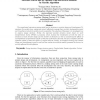10689 search results - page 305 / 2138 » How informances can be used in design ethnography |
116
click to vote
COOPIS
2002
IEEE
15 years 4 months ago
2002
IEEE
The design of virtual workplaces that can support virtual work processes has traditionally been either ad-hoc, or has been influenced by the top-down approaches, such as ‘virtua...
IV
2008
IEEE
15 years 5 months ago
2008
IEEE
Design rationale remains poorly explained and rarely modelled on projects in industry. However, the reasons for design decisions are important when a specification has to be re-ex...
JCIT
2010
14 years 6 months ago
2010
The complicated interactions among tasks lead to iterations in product design and development. To maintain the market share, enterprises should effectively manage their product de...
ICC
2007
IEEE
15 years 5 months ago
2007
IEEE
— When the node density in a network decreases below the level necessary to sustain ad-hoc and mesh networks, communication can succeed only by leveraging node mobility and trans...
106
click to vote
TC
2010
14 years 9 months ago
2010
—Superpeer architectures exploit the heterogeneity of nodes in a peer-to-peer (P2P) network by assigning additional responsibilities to higher capacity nodes. In the design of a ...


